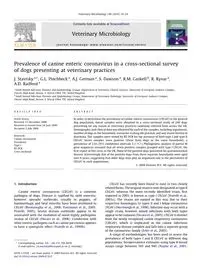
2010 Prevalence of canine enteric coronavirus in a cross-sectional survey of dogs presenting at veterinary practices PDF
Preview 2010 Prevalence of canine enteric coronavirus in a cross-sectional survey of dogs presenting at veterinary practices
Prevalence of canine enteric coronavirus in a cross-sectional survey of dogs presenting at veterinary practices J. Stavisky a,*, G.L. Pinchbeck a, A.J. German a, S. Dawson a, R.M. Gaskell b, R. Ryvar a, A.D. Radford a a Small Animal Infectious Diseases and Epidemiology Groups, Department of Veterinary Clinical Sciences, University of Liverpool, Leahurst Campus, Chester High Road, Neston, S. Wirral CH64 7TE, United Kingdom b Small Animal Infectious Diseases and Epidemiology Groups, Department of Veterinary Pathology, University of Liverpool, Leahurst Campus, Chester High Road, Neston, S. Wirral CH64 7TE, United Kingdom 1. Introduction Canine enteric coronavirus (CECoV) is a common pathogen of dogs. Disease is typified by mild enteritis; however sporadic outbreaks, usually in puppies, of haemorrhagic and fatal enteritis have been attributed to CECoV (Buonavoglia et al., 2006; Evermann et al., 2005; Pratelli, 2005). Severe disease outbreaks appear to be associated with the evolution of novel highly pathogenic strains of CECoV (Decaro et al., 2008). Coinfection with other enteric pathogens such as canine parvovirus appears to have a synergistic effect (Pratelli et al., 1999b). CECoV has recently been found to exist in two closely related forms. The original strain isnow designated as type II CECoV, whereas the more recently identified strain, first reported in 2003, is known as type I CECoV (Pratelli et al., 2003a). The strains are named in this way due to their respective homologies to types II and I feline coronavirus (FCoV) (Herrewegh et al., 1998). Infection may occur with a single strain, however mixed infections with both types appear to be common (Decaro et al., 2005). CECoV is distinct from the newly recognised canine respiratory coronavirus (CRCoV), which is implicated in the canine infectious respiratory disease complex and falls into a separate group of the coronavirus family (Erles et al., 2003). A range of methodologies has been used to assess the prevalence of both types I and II CECoV in different dog populations. Seroprevalence estimates using type II-based assays range between 16% and 94% (Naylor et al., 2001; Veterinary Microbiology 140 (2010) 18–24 A R T I C L E I N F O Article history: Received 12 December 2008 Received in revised form 24 June 2009 Accepted 3 July 2009 Keywords: Canine coronavirus Prevalence Type I RT-PCR Cross-sectional A B S T R A C T In order to determine the prevalence of canine enteric coronavirus (CECoV) in the general dog population, faecal samples were obtained in a cross-sectional study of 249 dogs presenting for any reason at veterinary practices randomly selected from across the UK. Demographic and clinical data was obtained for each of the samples, including signalment, number of dogs in the household, reason for visiting the practice, and any recent history of diarrhoea. The samples were tested by RT-PCR for the presence of both type I and type II CECoV. Seven samples were positive (three from dogs in the same household), a prevalence of 2.8% (95% confidence intervals 1.1–5.7). Phylogenetic analysis of partial M gene sequences revealed that all seven positive samples grouped with type I CECoV, the first report of this virus in the UK. None of the positive dogs presented for gastrointestinal disease. Interestingly five of the positive dogs from three separate households were aged over 6 years, suggesting that older dogs may play an important role in the persistence of CECoV in such populations. � 2009 Elsevier B.V. All rights reserved. * Corresponding author. Tel.: +44 151 794 6078. E-mail address:
